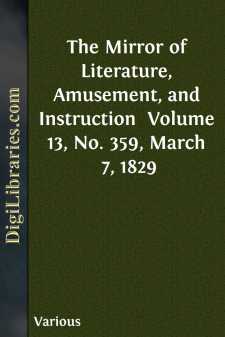Categories
- Antiques & Collectibles 13
- Architecture 36
- Art 48
- Bibles 22
- Biography & Autobiography 813
- Body, Mind & Spirit 142
- Business & Economics 28
- Children's Books 15
- Children's Fiction 12
- Computers 4
- Cooking 94
- Crafts & Hobbies 4
- Drama 346
- Education 46
- Family & Relationships 57
- Fiction 11828
- Games 19
- Gardening 17
- Health & Fitness 34
- History 1377
- House & Home 1
- Humor 147
- Juvenile Fiction 1873
- Juvenile Nonfiction 202
- Language Arts & Disciplines 88
- Law 16
- Literary Collections 686
- Literary Criticism 179
- Mathematics 13
- Medical 41
- Music 40
- Nature 179
- Non-Classifiable 1768
- Performing Arts 7
- Periodicals 1453
- Philosophy 64
- Photography 2
- Poetry 896
- Political Science 203
- Psychology 42
- Reference 154
- Religion 513
- Science 126
- Self-Help 84
- Social Science 81
- Sports & Recreation 34
- Study Aids 3
- Technology & Engineering 59
- Transportation 23
- Travel 463
- True Crime 29
The Mirror of Literature, Amusement, and Instruction Volume 13, No. 359, March 7, 1829
by: Various
Categories:
Description:
Excerpt
RUGBY SCHOOL
RUGBY SCHOOL
On the eastern border of Warwickshire, about 13 miles from Coventry, and 16 from Warwick, stands the cheerful town of Rugby, a place of great antiquity, but of little note previous to the erection of a grammar-school there, towards the close of the sixteenth century. The circumstances under which this school was founded, and the rank it has attained among our classical seminaries, may probably be interesting to the reader.
Rugby School was founded in the ninth year of Elizabeth, by Lawrence Sheriff, grocer, of London, chiefly as a free grammar-school for the children of the parishes of Rugby and Brownsover, and places adjacent. For the accommodation of the master, who was, "if it conveniently might be, to be ever a Master of Arts," he bequeathed a messuage at Rugby, in which it is probable he had himself resided during the last few years of his life, and he directed that there should be built, near this residence, a fair and convenient school-house, to defray which expense, and of a contiguous almshouse, he bequeathed the revenue of the rectory of Brownsover, and a third portion of twenty-four acres of land, situate in Lamb's Conduit Fields, "near London," and termed the Conduit Close. These eight acres were of trivial value at the period; and in 1653, the trustees of the property paid the schoolmaster a salary of 12l. a year, and each of the alms-men 7s. 7d. In 1686, the Lamb's Conduit property was leased for fifty years at 50l. per annum. The metropolis increased, and stretching one of its Briareusian arms in this direction, the once neglected field rose in value, and in 1702 (thirty-four years before the expiration of the above term) the trustees granted a fresh lease to William (afterwards Sir William) Milman, of forty-three years, to commence at the termination of the former lease. Building was not then a mania, and Sir William obtained his term for 60l. per annum; so that until the year 1780, the annual produce of the estate belonging to the Rugby charity, was only 116l. 17s. 6d.! But, shortly after the grant of an extended term to Sir W. Milman, handsome streets of family houses sprung up, and it was computed that a ground-rent of at least 1,600l. would accrue to the charity on the expiration of his lease. A much greater income has, in fact, arisen, and the revenues will be materially increased on the termination of the present leases.
The flourishing finances of this noble institution are well managed by twelve trustees, chosen from the nobility and gentry of the country.
The ancient buildings of the Rugby seminary were a humble tenement for the schoolmaster, a principal school-room, and two or three additional school-rooms, built at different times, as the finances would allow. These being found too limited, in 1808 the trustees commenced the erection of the present structure, from the designs of Mr. Henry Hakewill. It stands nearly on the same spot as the former humble building, and is composed of white brick, the angles, cornices, and dressings to the windows and openings being of Aldborough stone....












